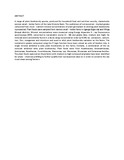The role of nutraceutical- implied empirical grades of plant foods in eliciting plant biodiversity on women small holder farms

View/
Date
2009Author
Namutebi, Agnes
Akundabweni, Levi S M
Kimiywe, Juditih
Language
enMetadata
Show full item recordAbstract
A range of plant biodiversity species, produced for household food and nutrition
security, characterize women small
-
holder farms of the
Lake Victoria Basin. The
usefulness of nutraceutical
-
implied grades computed from micro
-
nutrient mineral
concentrations of plant germplasm in eliciting plant biodiversity is presented. Plant
foods were sampled from women small
-
holder farms in Iganga (Ugan
da) and Vihiga
(Kenya) districts. Mineral concentrations were measured using Energy dispersive X
-
ray fluorescence spectroscopy (XRF), converted to nutrametric scores (1
-
10) and
grades (low, medium and high). Six minerals were consistently found in a decre
asing
concentration order (p>0.05) viz.: potassium, calcium, iron, Zinc, manganese and
strontium and used to elicit plant biodiversity variation on the farms. The
nutrametric grades computed using the If logic function have been coined as units of
biodive
rsity. A single mineral exhibited a wide plant biodiversity on the farms.
Similarly, a combination of the six minerals exhibited wide plant biodiversity. Plant
foods were from
Acanthaceae, Amaranthaceae, Asteraceae, Basellaccae,
Cucurbitaceae, Dioscoreac
cae, Moraceae, Musaceae
and
Solanacea
families. The
plant foods captured on these farms with medium to high nutraceutical grades have
been identified for phyto
-
chemical profiling to further qualify their nutraceutical
value to in order to conserve the see
d and share among farmers
Citation
Namutebi, Agnes., Akundabweni, Levi SM., Juditih, Kimiywe (2009). The role of nutraceutical- implied empirical grades of plant foods in eliciting plant biodiversity on women small holder farms. 13th NAPRECA symposium book of abstracts (pg. 26-27). August 10-14, 2009Publisher
University of Nairobi
